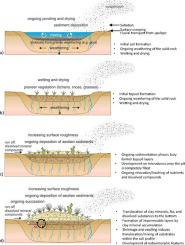Catena ( IF 5.4 ) Pub Date : 2020-12-24 , DOI: 10.1016/j.catena.2020.105084 Nele Meyer , Michael Kuhwald , James F. Petersen , Rainer Duttmann

|
Weathering pits form on various rock types worldwide and often contain unique ecosystems in periodically flooded or desiccated depressions. However, little is known about soil formation in such pits. Here, we investigated two weathering pits (WP1 and WP2) on the summit of Enchanted Rock, a granitic exfoliation dome in central Texas. We aimed at unravelling the origin of the parent material, evaluating evidence for dating the soil development, and identifying the major soil forming processes. We sampled five soil profile cores in each pit and analyzed diverse soil properties, such as C and N contents, pH, exchangeable cations, texture, and iron oxides. In addition, we performed energy dispersive X-ray spectroscopy and applied optically stimulated luminescence (OSL) and 14C dating analyses. Both pits were affected by redoximorphic features and organic matter accumulation (2.5 ± 1.4% C in the topsoil). WP1 revealed Na accumulation in the subsoil and pronounced translocation of clay minerals, which accumulated at the bottom (up to 50% clay in the subsoil, 13–34% in topsoil). Such processes were absent in WP2, in which clay contents and their variations were comparatively small (16–25%). Here, acidic and nutrient poor soil horizons (pH 4.0–4.4, 0.5–1.5% C, 4.1–4.6 mg kg−1P) alternated several times with nutrient rich and neutral soil horizons (pH 5.1–5.6, 2.0–2.5% C, 23–33 mg kg−1P). This phenomenon was observed down to the bottom of the pit. We conclude that the parent material for soil development consists of three sources: autochthonous material from in-situ weathering of the solid rock, granitic grus particles from upslope positions, and eolian sediments from the area surrounding Enchanted Rock. Phases of sedimentation may have alternated with phases of stability and topsoil formation, resulting in buried former topsoils. OSL dating revealed that sedimentation began not later than 5110 years ago in 42 cm depth of WP1 and 2290 years ago in 26 cm depth of WP2. Due to contamination by younger carbon, 14C dates underestimate the beginning of soil development. The intensity of post sedimentary soil forming processes (clay mineral translocation, sodium enrichment, ferrolysis, organic matter accumulation) depends on the age of the pit and on its morphology, i.e. on the possibility of water and dissolved substances running off.
中文翻译:

德克萨斯州中部花岗岩穹顶(附魔岩)风化坑中的土壤发育
风化坑遍布全球各种岩石,通常在周期性淹没或干燥的洼地中包含独特的生态系统。然而,关于这种坑中土壤形成的了解很少。在这里,我们研究了位于得克萨斯州中部的花岗岩剥落圆顶Enchanted Rock的山顶上的两个风化坑(WP1和WP2)。我们的目的是弄清母体材料的起源,评估与土壤发育年代相关的证据,并确定主要的土壤形成过程。我们对每个坑中的五个土壤剖面核心进行了采样,并分析了各种土壤特性,例如碳和氮含量,pH,可交换阳离子,质地和氧化铁。此外,我们进行了能量色散X射线光谱分析,并应用了光激发发光(OSL)和14C约会分析。两个坑都受到氧化还原形态特征和有机质积累(表土中2.5±1.4%C)的影响。WP1揭示了Na在地下土壤中的富集和黏土矿物的明显迁移,这些矿物在地下积聚(地下土壤中粘土的含量高达50%,表层土壤中的含量高达13–34%)。WP2中没有这样的过程,其中粘土含量及其变化相对较小(16–25%)。在这里,酸性和营养不良的土壤层(pH 4.0–4.4、0.5–1.5%C,4.1–4.6 mg kg -1 P)与营养丰富的土壤层和中性土壤层(pH 5.1–5.6、2.0–2.5%C )交替出现几次,23–33 mg kg -1P)。观察到这种现象直至坑的底部。我们得出的结论是,土壤发育的母体材料包括三个来源:固体岩石原位风化的原生物质,上坡位置的花岗岩团粒颗粒以及附魔岩周围的风积物。沉积阶段可能与稳定阶段和表土形成阶段交替出现,从而导致前表土被掩埋。OSL测年表明,沉积不早于5110年前开始于WP1的42厘米,而2290年前开始于WP2的深度。由于年轻的碳污染,14碳日期低估了土壤发展的开始。沉积后土壤形成过程的强度(粘土矿物的迁移,钠富集,铁解作用,有机物质的积累)取决于矿坑的年龄及其形态,即取决于水和溶解性物质流失的可能性。











































 京公网安备 11010802027423号
京公网安备 11010802027423号